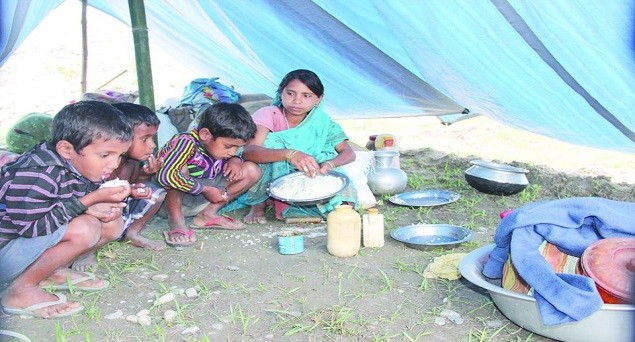By IndiaTomorrow.net,
New Delhi, 12 Nov 2014: Assam has witnessed mass violence at regular interval since 1993 claiming hundreds of human lives mostly of Bengali-speaking Muslim citizens of the north-eastern state of India. A US-based civil group has released a 34-page report exposing roots of atrocities against the minority during the riots particularly in the years 2012 and 2014.
The report titled “Rationalizing Ethnic Cleansing in Assam,” is based on data provided by human rights activists in Assam, media reports, eyewitness accounts as well as testimonies of scores of victims, many of which have been recorded.
The report, released by the Indian American Muslim Council (IAMC), an advocacy group dedicated to safeguarding India’s pluralist and tolerant ethos, documents the complicity of state machinery behind sustained violence against an ethnic and religious minority.
The report says it is a myth that most of Assamese Muslims are illegal immigrants from Bangladesh. It is a “canard that is all too often used to contextualize, the barbaric ethnic cleansing of impoverished Muslim villagers,” says the report.
“The political patronage provided to armed militant groups that have spearheaded massacres at regular intervals since 1993, and the hateful rhetoric of xenophobic Hindutva groups, is at the root of the campaign to bring about demographic changes in Assam through violence and intimidation,” said Mr. Ahsan Khan, President of IAMC.
“The gravity of the situation in Assam can be gauged from the fact that the state has failed to provide adequate relief or create an atmosphere conducive to the return of the thousands who were displaced from their homes during the mass violence,” he added.
Major cases of large-scale organized violence against non-Bodos
Since the late 1980s the political violence against non-Bodos in the areas of Assam between the Brahmaputra River and Kingdom of Bhutan showed several broad patterns:
— In 1987, organized violence against ‘Assamese’ (caste Hindu) and Koch-Rajbangshi villagers made them flee the northern areas of the Bongaigaon (now Chirang) District.
— In October 1993, after the signing of the Memorandum of Settlement (Bodo Accord) in Guwahati, Assam on 20 February 1993)3 that formed Bodo Automonous Council (BAC), large-scale violence against Muslim villagers in the Kokrajhar and Bongaigaon Districts left at least 18,000 Muslims displaced. Few of those displaced could return home or were rehabilitated. For instance, 42 Muslim families displaced from villages in the Bengtol Revenue Circle of the Chirang District remain in a squalid relief camp even after 21 years.
— In July 1994, large-scale violence against Muslims in the Barpeta District left at least 56,000 Muslim villagers displaced and more than 100 were killed. At least 40 Muslim villagers taking shelter in a relief camp in Bansbari were gunned down by Bodo militants who attacked the camp. The area is now in the Baksa District, the same area where two of the latest massacres in May 2014 is repeated.
— In May 1996, violence against the Adivasis in the Kokrajhar and Bongaigaon Districts left many dead and at least 262,600 displaced.
— In September 1998, renewed violence against Adivasis left at least 314,000 displaced.
— In 2008, clashes between Bodos and Muslims in the Udalguri District left at least 200,000 displaced.
— In 2012, large-scale violence unleashed against Muslim villagers in the Kokrajhar and Chirang Districts left at least 450,000 displaced.
Recommendations for reconciliation between Muslims and Bodos
The report includes wide-ranging recommendations to bring about reconciliation between Muslims and ethnic Bodos.
1. Appropriate judicial intervention must be brought in expeditiously in the matter of the recent massacre in May 2014 to ensure justice for the victims and survivors through an independent investigation by the National Investigation Agency.
2. In addition to the above, a Special Investigation Team (SIT) under the supervision of Supreme Court of India must be immediately put in place to comprehensively assess the violence that has occurred in the BTAD since the late 1980s.
3. The State must ensure adequate compensation, prevent forced eviction of the returnees to their habitual residents, and provide housing and livelihood assistance as well as education and skill training.
4. The State must ensure that member of all communities have equal access to economic opportunities and political power. The terms of the Memorandum of Settlement on the basis of which the Bodo Territorial Council was created under Sixth Schedule must be completely reviewed. There cannot be any democratic or constitutional basis for the reservation of 75% of seats in a legislature of a specially administered region for a particular group which barely constitutes 33% of the population. This review must also make way for electoral democracy for local governance in the BTAD which is barred there.
5. The State must adopt immediate actions to disarm the surrendered armed groups operating in the BTAD completely.
6. The State must adopt a long term counterinsurgency strategy in order to neutralize armed elements and confiscate illegal weapons in order to avoid loss of innocent lives.





